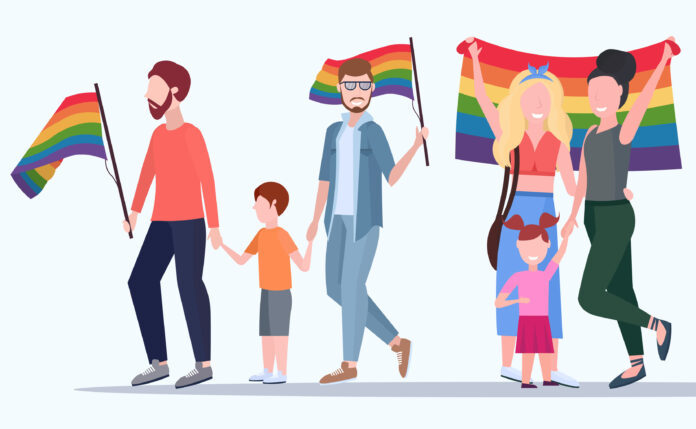A new study of LGBTQ+ parents found that two-thirds of the participants — and especially trans parents — said their children experienced structural and/or interpersonal stigma at school. The parents, however, shared a variety of proactive and reactive ways they worked to prevent or offset such stigma.
The research is part of a larger study of LGBTQ+ family building and parenting, led by Professor Abbie Goldberg of Clark University, with data gathered via an online survey in the summer of 2020. For the current paper, “LGBTQ Parents’ Accounts of Their Children’s Experiences With Heterosexism in Schools,” published in the journal Psychology of Sexual Orientation and Gender Diversity (March 14, 2024), Goldberg and independent scholar JuliAnna Smith focused on the responses of 419 LGBTQ parents, consisting of 65% cisgender women, 22% cisgender men, and 13% transgender or nonbinary parents. Previous studies of LGBTQ+ families and schools have used much smaller samples and focused only on families with cisgender parents.
Goldberg and Smith found that parents of older children ages 11 to 18 were more likely to report stigma than those with children ages 6 to 10, who in turn were more likely to report it than those with children under 6. Additionally, trans parents were more likely to report this than gay male parents (and slightly more likely than lesbian and bi parents, but not to statistical significance. (See the paper for full statistical analysis.)
Many of the parents described structural, indirect ways their children had been marginalized, such as being “excluded via assignments, curricula, and language that was fundamentally heteronormative and cisnormative,” the paper says. Several parents spoke of how a focus on “White, biogenetically related families” marginalized their children on the basis of race and adoptive status as well.
Some parents, most with elementary school children, said their children had encountered misunderstandings or confusion about their family without overt hostility. The parents knew this was “developmentally appropriate but also rooted in a heteronormative society and school system,” the authors note.
The parents applied a variety of strategies to address this structural stigma. Many asked teachers for classroom changes related to Mother’s/Father’s Day assignments, family history projects, and use of the correct parental titles, among other things. They recommended and sometimes donated books and other resources on LGBTQ families, adoption, and related topics. Some volunteered for school events or committees, hoping to normalize their family, promote understanding, and have influence in the school.
Others, most but not all with middle school children, reported that their children experienced more explicit anti-LGBTQ+ actions, usually by peers: for example, where children were told their parents would go to hell. Some parents, too, said their children had heard anti-LGBTQ+ slurs that were not directed at them. A few described teasing or bullying aimed at the children’s own nonconforming gender expression.
Parents often spoke with teachers and/or administrators about such incidents, and these conversations “sometimes, but not always” led to positive change. A few families, however, filed formal complaints, requested different teachers, or even changed to a new school.
Many parents also undertook proactive strategies to reduce their children’s exposure to stigma and build their resilience. These included conveying positive messages about diverse families, particularly when the children were younger. Some sought LGBTQ-inclusive schools or playgroups. Regardless of whether they did, more than a quarter of the parents said they were intentionally open about their family and often had “purposeful conversations” with school staff at the beginning of the school year, offering details such as the name(s) the child calls their parent(s) or explaining the involvement of a birth parent or known sperm donor in their lives.
Parents spoke of “reducing their involvement and oversight” as their children grew older, though, encouraging them to “become their own advocates,” and talking with them about safety and nonviolent ways of responding to anti-LGBTQ+ actions if they did occur. And particularly in middle school, the children were sometimes less likely to disclose their family structure or parents’ LGBTQ+ identities, in order to blend in or avoid questions. Most parents allowed them to make their own decisions in this regard, too.
The research has a few limitations, including its reliance on parents’ reports rather than those of the children, and on a sample of mostly white, well-educated parents. Additionally, the study excluded bisexual parents in different-sex relationships and single parents in order to focus on families whose parents are more likely to be viewed as a sexual or gender minority. Further research, they say, should seek to fill these gaps and others — and to explore “how LGBTQ parents and their children are navigating increasingly hostile school environments” in the current political climate, amid a growing number of anti-LGBTQ+ curriculum laws and policies.
Goldberg and Smith say their study nevertheless shows a range of structural and personal ways children of parents across the LGBTQ+ spectrum have been excluded and stigmatized in schools and how this may be experienced differently at different ages. This may aid school professionals and therapists in understanding children’s varied responses to stigma over time. The findings point to the need for more inclusive school policies, for teacher training on LGBTQ+ families, sexuality, and gender diversity, and for interventions in the early grades.
For us LGBTQ+ parents, I’ll add, such research also provides examples of how other queer families have prepared for and handled stigma at school. No child should have to experience exclusion or marginalization, but until that perfect world is achieved, studies like this can offer useful insights.
